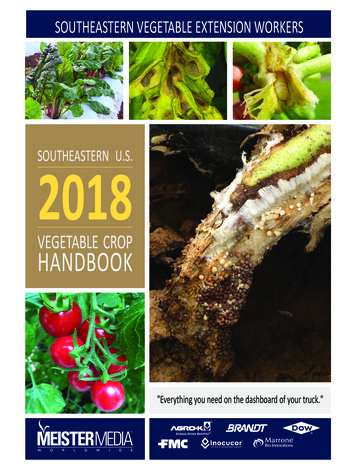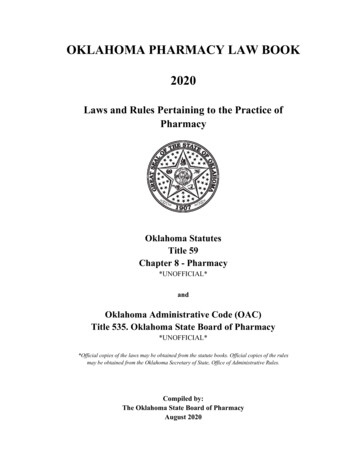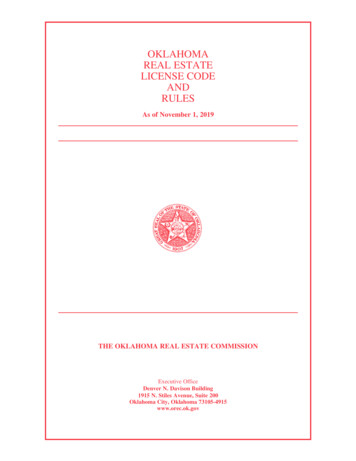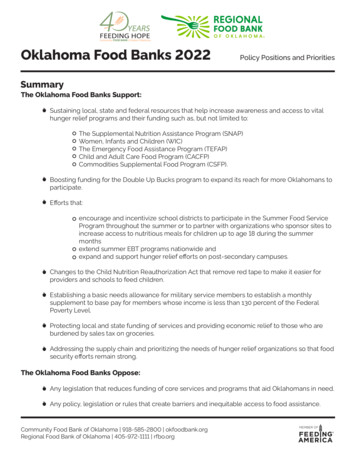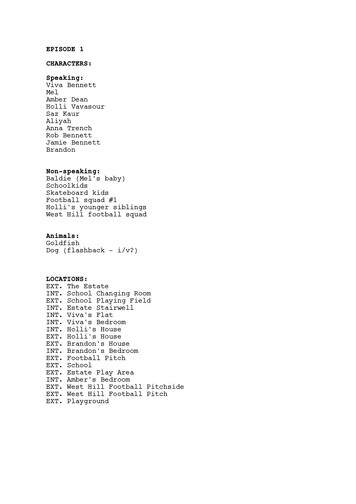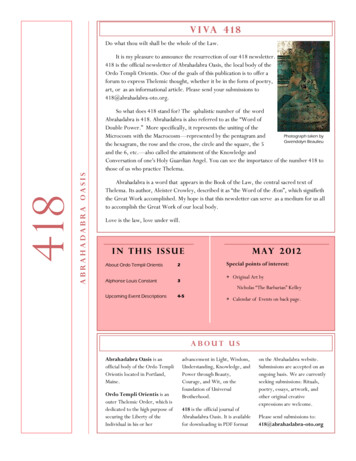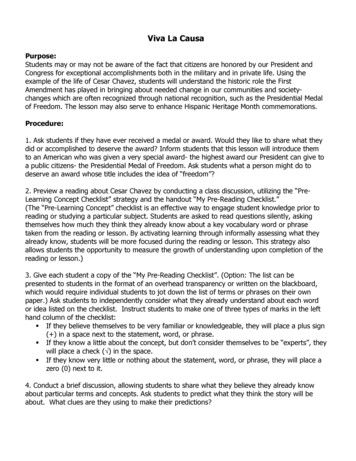
Transcription
Viva La CausaPurpose:Students may or may not be aware of the fact that citizens are honored by our President andCongress for exceptional accomplishments both in the military and in private life. Using theexample of the life of Cesar Chavez, students will understand the historic role the FirstAmendment has played in bringing about needed change in our communities and societychanges which are often recognized through national recognition, such as the Presidential Medalof Freedom. The lesson may also serve to enhance Hispanic Heritage Month commemorations.Procedure:1. Ask students if they have ever received a medal or award. Would they like to share what theydid or accomplished to deserve the award? Inform students that this lesson will introduce themto an American who was given a very special award- the highest award our President can give toa public citizens- the Presidential Medal of Freedom. Ask students what a person might do todeserve an award whose title includes the idea of “freedom”?2. Preview a reading about Cesar Chavez by conducting a class discussion, utilizing the “PreLearning Concept Checklist” strategy and the handout “My Pre-Reading Checklist.”(The “Pre-Learning Concept” checklist is an effective way to engage student knowledge prior toreading or studying a particular subject. Students are asked to read questions silently, askingthemselves how much they think they already know about a key vocabulary word or phrasetaken from the reading or lesson. By activating learning through informally assessing what theyalready know, students will be more focused during the reading or lesson. This strategy alsoallows students the opportunity to measure the growth of understanding upon completion of thereading or lesson.)3. Give each student a copy of the “My Pre-Reading Checklist”. (Option: The list can bepresented to students in the format of an overhead transparency or written on the blackboard,which would require individual students to jot down the list of terms or phrases on their ownpaper.) Ask students to independently consider what they already understand about each wordor idea listed on the checklist. Instruct students to make one of three types of marks in the lefthand column of the checklist: If they believe themselves to be very familiar or knowledgeable, they will place a plus sign( ) in a space next to the statement, word, or phrase. If they know a little about the concept, but don’t consider themselves to be “experts”, theywill place a check ( ) in the space. If they know very little or nothing about the statement, word, or phrase, they will place azero (0) next to it.4. Conduct a brief discussion, allowing students to share what they believe they already knowabout particular terms and concepts. Ask students to predict what they think the story will beabout. What clues are they using to make their predictions?
5. Read aloud to the class the story entitled “Viva La Causa: The Story of a Hispanic Leader WhoBelieved in the First Amendment. Every time a word or phrase from the checklist is heard,students should raise their hands. Be sure to pause periodically to check for understanding of theevents of the story or to clarify necessary vocabulary.6. Following the reading, ask students to return to their own checklists and measure his or hergrowth in learning by responding with the same symbols (as in step 3.) in the right hand columnof the checklist. Allow time for a de-briefing discussion, encouraging students to share what theyhave learned. What additional questions might they have about the life of Cesar Chavez? How didhe use the rights of the First Amendment to bring about change for migrant workers of theUnited States? Why do they believe President Clinton considered Mr. Chavez deserving of such ahigh honor as the Presidential Medal of Freedom?7. Give each pair of students one copy of the “Medal of Freedom Nomination” template. Askstudent pairs to imagine they are the President of the United States and his Press Secretary.They will be writing a joint statement, summarizing why Cesar Chavez is deserving of the award.Allow time for student volunteers to read their statements aloud.8. Extension: Using the handout “A Medal Worth More Than Gold”, review other individuals whohave been awarded the Presidential Medal of Freedom. Ask students if they have heard of any ofthese individuals? What do they share in common? How have these individuals used their right tofreedom of speech and expression? Interested students might be encouraged to research thelives and accomplishments of individuals on the list and share their findings with the class.9. Option: This lesson can be an effective supplement to the celebration of Hispanic HeritageMonth every September and October. A Power Point presentation is offered to commemorate thecontributions of Hispanic Americans, including reference to Cesar Chavez.
My Pre-Reading ChecklistBefore ReadingAfter Reading1. a cause2. farm worker3. petition4. violence5. peaceful6. justice7. migrant8. Hispanic9. wages10. newspaper11. barrio12. poverty13. public service14. Medal of Freedom
VIVA LA CAUSA:The Story of a Hispanic LeaderWho Believed in the First AmendmentThe story of Cesar Chavez begins near Yuma, Arizona,where he was born. But soon, his family moved to California,living in a “barrio” called Sal Si Puedes -"Get Out If You Can."Cesar thought the only way to get out of poverty wasto work hard.Cesar and his family worked in the fruit and vegetable farms ofCalifornia from sunrise to sunset. He did not learn much in school,because he only knew Spanish. He felt that education had nothingto do with a migrant farm worker’s way of life.While his childhood education was not the best, later in life, he learned to love reading.His home was filled with hundreds of books. He believed that the purpose of educationshould be service to others.In order to speak for the needs of the migrant workers who were being treated unfairly,Cesar started the National Farm Workers Association. Workers were paid very low wagesand worked long hours into the night. Even small children were working in the fieldsinstead of getting to go to school.Cesar read about the First Amendment’s right to free speech, assembly, and petition. He used what he hadlearned to gather the farm workers together into parades and marches. They carried banners, saying “VIVALA CAUSA” (long live the cause).The marchers wanted the government to pass lawswhich would make sure workers were treated justly.Cesar succeeded through nonviolent ways, such asparades and marches, using his and his followers’ FirstAmendment rights. Other famous Americans joinedCesar’s efforts, until soon newspapers printed storiesabout migrant workers in the fields of America.When he died, more than 50,000 people came to hisfuneral. For the last time, they came to march side-byside of the man who had taught them to stand up fortheir rights through peaceful ways.Years later, Helen Chavez, Cesar's wife, accepted theMedal of Freedom for her late husband from PresidentClinton. Cesar would be remembered for supportingfarm workers’ First Amendment right to speak out for them.
From the Office of the PresidentThe White House1600 Pennsylvania AvenueWashington, D.C.I bestow to Mr. Cesar Chavez this Presidential Medal of Freedom
A Medal Worth More Than GoldThe Presidential Medal of Freedom is an award given by the President of the United States.It is the highest civilian award offered. It is given to individuals who have made a contributionto the United States, world peace, or other significant public endeavors.The following is a list of some of the winners of this award.What do they have in common with the liberties protected by the First Amendment?Name:David BrinkleyRachel CarsonWill DurantDuke EllingtonBilly GrahamBob HopeHelen KellerEdward MurrowPaul HarveyNorman RockwellJohn SteinbeckElie WieselOccupation:Newspaper and Television reporterScientist and non-fiction authorHistorian and authorMusic composerMinister and authorComedian and entertainerAuthor and political activistNewspaper, radio, and television reporterRadio journalistArtistNovelistAuthor and Human Rights activist
The story of Cesar Chavez begins near Yuma, Arizona, where he was born. But soon, his family moved to California, living in a "barrio" called Sal Si Puedes -"Get Out If You Can." Cesar thought the only way to get out of poverty was to work hard. Cesar and his family worked in the fruit and vegetable farms of California from sunrise to sunset.

